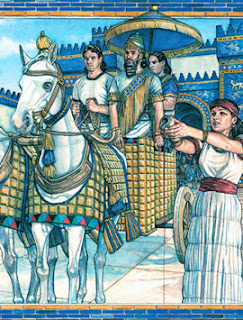The game is named after the Tigris and Euphrates, two rivers that produced the Fertile Crescent and gave rise to what is commonly called the cradle of civilization in the Middle East. It was around this area that Mesopotamia supported some of the earliest urban settlements, which eventually included the Sumerian, Babylonian, Akkadian, and Assyrian empires.
What is the Tigris and Euphrates?
Tigris and Euphrates was one of the first games published by Knizia after he became a full-time professional game developer in 1997. Game play takes place on a map between and around the Tigris and Euphrates rivers at the dawn of civilization, with two to four players attempting to create a winning and lasting dynasty.
To do it, players draw and place tiles and leaders that represent various elements of civilizations — temples and priests (red), farms and farmers (blue), markets and merchants (green) and settlements and kings (black). With each turn, players attempt to expand their empires, represented by the Potter, Archer, Bull, and Lion.
The goal of the game is to develop four key aspects of civilization in the most balanced way possible, which includes part of the twist to one of Knizia's most popular games. The lowest scoring aspect — spiritual, agricultural, commerce, and government — will determine the winner, not the highest.
 In addition to receiving victory points for possessing placed tiles connected by a leader, players can expedite the accumulation of victory points by collecting treasures, building monuments, and winning conflicts. Monuments deliver specific victory points during each turn of play (but leave kingdoms vulnerable to attack) while treasures serve as a wild victory point placed in their lowest scoring aspect.
In addition to receiving victory points for possessing placed tiles connected by a leader, players can expedite the accumulation of victory points by collecting treasures, building monuments, and winning conflicts. Monuments deliver specific victory points during each turn of play (but leave kingdoms vulnerable to attack) while treasures serve as a wild victory point placed in their lowest scoring aspect.Conflicts are the most strategic plays of the game. They arise any time a leader is placed in a kingdom with an existing leader of the same color (a revolt) or when two kingdoms with leaders are united. In addition to quickly expanding an empire, they effectively force the losing player to start over.
There are a few other nuanced features, such as catastrophe tiles, but the basics cover the general spirit of the game. Although it is similar to Samurai as a strategy-based tile game, most people consider this game Knizia's masterpiece. (Others might argue that he has had dozens.)
The brilliance of bringing the game to mobile devices.
Tigris and Euphrates always had a complex scoring system, which is alleviated by the computer taking over the role. Tallying victory points takes place in real time, allowing players to immediately recognize what aspects they need to shore up before the final rounds of the game. Likewise, any missed conflicts are immediately identified and reconciled.
Although the game might feel intimidating the first few times, the optional tutorial and pop-up tips not only teach you how to play, but also give you a good grasp of the strategy involved. There is even a hint feature against AIs if you feel especially lost. It helps diminish the learning curve.
Most players will start playing against one to three AIs, which have slightly different personalities and adjustable difficulties. In lieu of the AIs, you can use the app as a pass-and-play game or look for friends and random strangers to play against.
As with many adapted board games, there is never a shortage of people (or AIs) to play against and never anything to set up or pick up after the game. Game play is relatively short, about 30 minutes (more or less) depending on how long you or other players take to move pieces. More experienced players might take longer.
Reiner Knizia's Tigris and Euphrates Captures 8.7 On The Liquid Hip Richter Scale.
Although most people will find Samurai easier to play, Tigris and Euphrates is the more engaging game. The game play is smart as a strategic and tactical game that relies on only a little luck (tile draws), providing an enjoyably complex game that feels deceptively simpler on the iPhone, iPod, and iPad. And graphics are adequate, blending the vintage qualities of the board game with the on-screen interface.
Kudos also goes to Codito Development and Sage Board Games, which rendered Tigris and Euphrates into an app. They have brought several boutique board games to market with the iPad in mind, including Knizia's Ra. It's a job well done, especially in that it changes the way people think about games.
You can find Tigris and Euphrates on the App Store via iTunes. Or, you can look for the out-of-print board game, last published by Mayfair Games, on Amazon. The Tigris and Euphrates board game includes a double scenario edition, which features a different map on the backside of the game board. The game is beautifully produced, with hundreds of painted wood pieces and illustrated tiles. (The top image is from the latest republishing.)
![Liquid [Hip]](https://blogger.googleusercontent.com/img/b/R29vZ2xl/AVvXsEjAFBQPqS7J0-rrttNoRYSsuwIePPZf4Nq6sqDioK1zzVQXJIQXKzq_NVNI4n6h3inuRQFBKOcJeZeSufkdHHIOxbSWyBjTjTxgKEQGyPzdwvkEEeECh4bI5YEGk4RWGUINSd7vulPQsCA/s1600-r/liquidhip.jpg)

